Editor’s Note: This is the first of three stories we’ll be rolling out on the active players with interesting Hall of Fame cases. We’ll cover outfielders on Monday and designated hitters and pitchers on Tuesday.
The Baseball Hall of Fame is meant to appreciate the best to ever play the sport. The primary discussion among fans surrounding Cooperstown, however, centers on the borderline cases—the guys who deserve to be enshrined in the minds of some and who simply rise to the Hall of Very Good in the minds of others.
Sure, we honor the shoo-ins such as Derek Jeter, Ken Griffey Jr. and Mariano Rivera. But we vouch hardest for our favorites who are expected to come perilously close to that 75% cutoff of affirmative votes needed for induction. So, this column won’t be devoted to the active MLB players who could already start rehearsing their induction speeches. Instead, I’ll try to get an early start on highlighting the players most likely to spend the maximum 10 years on the ballot … or at least sweat it out for a few years.
With Barry Bonds, Roger Clemens, Sammy Sosa and Curt Schilling all officially off of the BBWAA ballot, in the coming years we thankfully won’t have to debate quite as many candidates with stains left from their use of performance-enhancing drugs. But as I’ll discuss below—not in-depth, thankfully, as we’ll have plenty of time for that—there’s still one scandal that could derail discussions for decades to come.
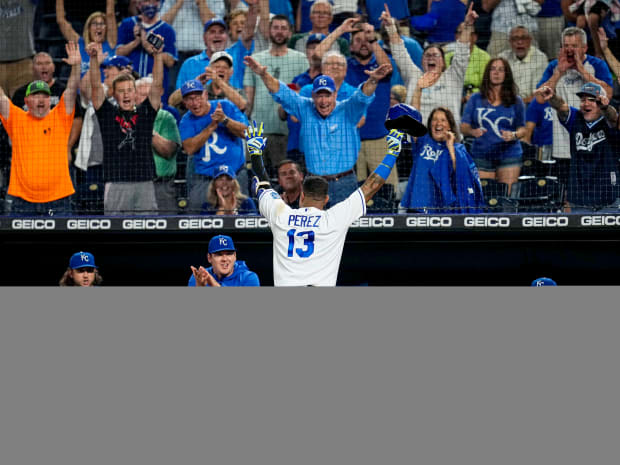
Jay Biggerstaff/USA TODAY Sports
Catcher: Salvador Perez
We’re starting off with a tricky situation. Yadier Molina is neck-and-neck with Buster Posey in the race to be the first catcher elected from the post-Pudge era; they rank first (Posey) and second (Molina) in WAR among catchers who debuted in 1996 or later. I think both should get in, but Posey would be my choice here if he hadn’t retired in November as his short career combined with a fantastic peak and postseason heroics makes for a fascinating case. Alas, he’s technically no longer active, and Molina’s longevity, championship pedigree and defensive chops are widely expected to help him overcome a mediocre offensive profile (career 97 OPS+ would place third-worst among HOF catchers).
No one else is in that pair’s zip code, but by setting the single-season positional record with an MLB-leading 48 home runs last season, Perez put himself in the conversation. The seven-time All-Star has now significantly raised his personal bar at the plate in back-to-back seasons after missing the entire 2019 campaign with an elbow injury. A five-time Gold Glover and four-time Silver Slugger who’s still only 31 years old, he has some time to rack up counting stats if he can maintain a degree of his offensive awakening. But his 29.6 WAR (38th among catchers) lags far behind the HOF positional average of 53.7 after 2021 represented the first 5.0 WAR season of his career. He likely left himself too much work to do with his hacktastic approach in the batter’s box through the 2010s.
Will Smith has reminded some Dodgers fans of a young Mike Piazza with 6.6 WAR through 221 career games, but he already turns 27 in March and has way too much mileage to make up.
HOF pick: Molina
He’s got potential: Perez, J.T. Realmuto
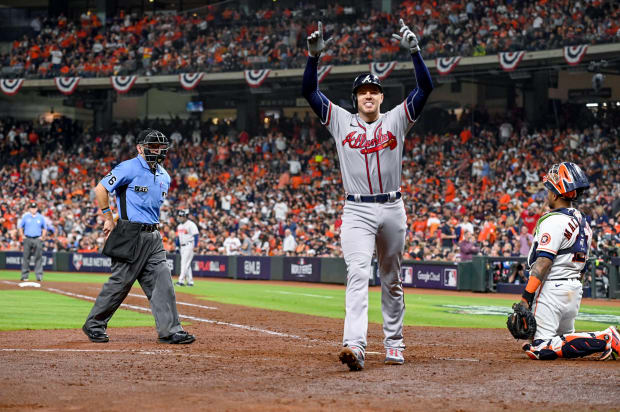
Greg Nelson/Sports Illustrated
First baseman: Freddie Freeman
Only six Hall of Fame first basemen have debuted since World War II due to an unfortunate mix of suspected PED users (Mark McGwire, Rafael Palmeiro, Jason Giambi), an underrated slugger whose candidacy never took off (Fred McGriff) and a few excellent contact hitters (John Olerud, Keith Hernandez, Will Clark) who didn’t quite possess the power to make their mark at a position expected to produce home runs in bunches.
Thankfully, there are several outstanding candidates set to increase that paltry number at some point this decade. Albert Pujols and Miguel Cabrera are already considered locks, and Joey Votto’s plate discipline and power resurgence has him in great position to be in the same boat by the time he hangs it up.
Freeman, the only active first baseman outside of that trio to win an MVP, has a burgeoning case, as I detailed in August. His odds only increased after leading Atlanta to a World Series title with Ronald Acuña Jr. sidelined for the second half of the season. Given his excellent clubhouse reputation, his intangibles figure to be a plus, too—especially if the Braves wise up after the lockout and make sure he winds down his prime in Atlanta. But with 271 career home runs, a relatively low mark for first basemen, the 32-year-old can’t afford to experience a power outage during his 30s. He still needs a few more 5.0 WAR years to catch up to the average JAWS score of Hall of Famers at his position. He hasn’t been able to notch 5.0 WAR since 2018 (though he was well on pace during the shortened 2020 campaign).
I could have just as easily placed Paul Goldschmidt here; they’re actually each other’s closest statistical match in MLB history by Baseball Reference’s similarity score, and both debuted in 2011. But Freeman’s age advantage—he’s almost exactly two years younger than Goldy—and collection of both individual and team hardware have him on a slightly better path.
HOF picks: Pujols, Cabrera, Votto, Freeman, Goldschmidt
He’s got potential: Anthony Rizzo, Pete Alonso, Vladimir Guerrero Jr.
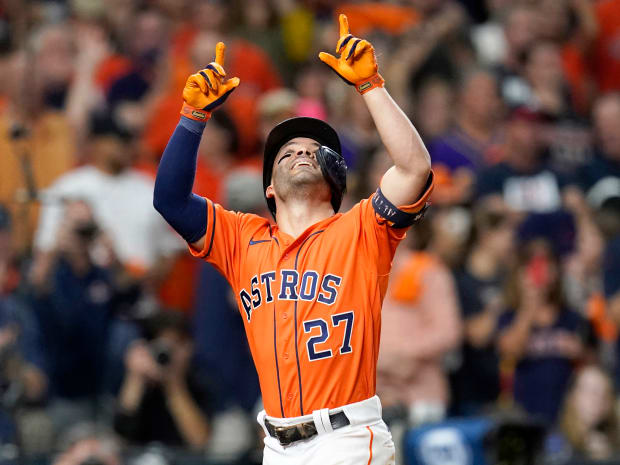
Thomas Shea/USA TODAY Sports
Second baseman: Jose Altuve
What once looked like a very encouraging case has absorbed a couple of body blows over the last two years. The 2020 season was mostly a wash, due to both its shortened length and Altuve’s poor performance. And, of course, the Astros’ sign-stealing scandal that came to light soiled every Houston hitter from the '17 World Series–winning team. Even though close examinations of the game film showed Altuve was one of the lightest offenders, just attend an Astros road game and see if you think most fans make that distinction when he’s at bat. There will be some writers who feel his involvement should act as a bigger obstacle to Cooperstown than using PEDs before they were outlawed by MLB.
Altuve’s argument starts with his 2017 MVP, when he won his third batting crown and led the AL in hits for the fourth straight year. He’s since sacrificed some of his elite contact skills for more power, mirroring the league-wide trend to middling effect. With 1,777 career hits through his age-31 season, it’d be a major stretch to count on his reaching the magic 3,000-hit threshold, which once seemed very doable. A two-time league leader in stolen bases, he’s swiped just 13 bags (and been caught stealing 11 times) over the last three years. On the bright side, with 164 home runs, he could very well become the fourth second baseman ever with 300 career HRs if he keeps up his 30-homer pace from the last two full seasons. And ranking second all-time with 23 postseason round-trippers is a nice feather in his cap. We’ll have to see how both he and the sign-stealing scandal ages as he nears eligibility.
Another scandal-ridden second baseman, Robinson Canó is an inner-circle Hall of Famer, statistically speaking. He ranks sixth all-time among second basemen in JAWS and 10th in WAR. But his pair of PED suspensions have all but eliminated him from contention. If Chase Utley doesn’t make the cut—I, for one, think he’s more than deserving—the keystone could be in for a loooooong drought.
HOF pick: None
He’s got potential: Altuve, Ozzie Albies (just turned 25!)
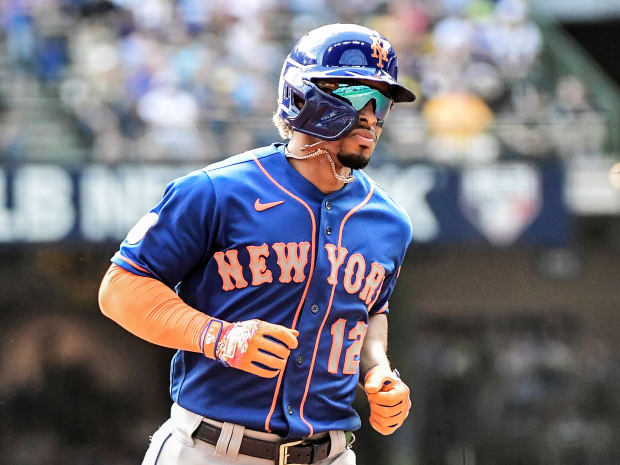
Benny Sieu/USA TODAY Sports
Shortstop: Francisco Lindor
The common refrain is that we’re living in a golden age for shortstops. While that may pertain to the position’s floor being raised league-wide (and the loaded 2022 free agent market), I’m not sure I would make that claim from the standpoint of the Hall of Fame. There’s a group of six stars in their late 20s who all have a shot at induction, in descending order: Carlos Correa, Francisco Lindor, Xander Bogaerts, Trevor Story, Corey Seager (whose injuries and defense really hurt his cause) and Trea Turner. But I don't think more than two end up garnering enough support when it's all said and done.
Correa’s main positives are his early start, having debuted at age 20, his stellar defense and the feeling that he’s only getting better. If you double the 34.1 WAR he’s accrued in his first seven seasons, he’ll be right at the HOF positional average of 67.7. But he only has two All-Star appearances and, like Altuve, carries the stench of Houston’s sign-stealing scandal. Lindor has looked awfully average at the dish over the last two seasons, but his first five years in Cleveland yielded four All-Star selections, two Gold Gloves and two Silver Sluggers, giving him a nice, well-rounded head start. The rest probably end up falling short, with Bogaerts’s offensive consistency giving him the best shot at running up the score on the counting stats like few shortstops have.
I do think the long runway ahead of Correa ends up getting him in. If we project the 27-year-old for an average of 20 home runs over the next 10 seasons, he gets to 333 HRs—behind only Alex Rodriguez, Ernie Banks and Cal Ripken Jr. among shortstops. He has a lot of time to rewrite his place in the history books. Lindor, meanwhile, seems like less of a sure thing after his recent struggles. If he can slightly rebound at the plate over the course of his 10-year extension with the Mets, he’ll also rank in the upper echelon of shortstops. But will that be enough? If he left his peak in Cleveland, I foresee a future argument between those arguing he was underrated while out of the spotlight there and those who’ll say he wilted under the spotlight of New York—the sort of tiresome discourse where people would be wedged on their side of the debate with Lindor stuck in ballot purgatory. Actually, I don’t need to look into my crystal ball for that. It’s already been happening.
Honestly, the guy I would bet on to be enshrined over all of them is Fernando Tatis Jr. His two top-five MVP finishes are already more than any of the five guys above. But at this point, with the 23-year-old’s talent so obvious and well-established, I’d project him to be well beyond the cut line as long as he can stay healthy.
HOF picks: Lindor, Correa, Tatis Jr.
He’s got potential: Bogaerts, Seager, Story, Turner, Wander Franco
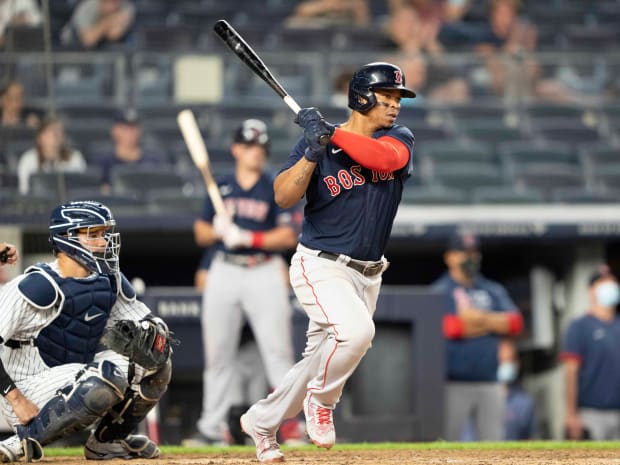
Gregory Fisher/USA TODAY Sports
Third baseman: Rafael Devers
Shortstops have been getting the shine as the standout position of this era, but the hot corner is also looking pretty good these days. An underrepresented area in the Hall of Fame with just 15 third basemen, that number could be set to steadily increase over the next couple of decades with Scott Rolen and Adrián Beltré clearing the way for a few contemporaries.
Nolan Arenado is the man I predict as the most likely to follow their lead among active players. With nine straight Gold Gloves to begin his career, he’d have a case even if he was just slightly above-average with the bat. Instead, he’s led the NL in home runs and finished in the top five of MVP voting three times apiece. Already ranked in the top 30 of JAWS among third basemen, a solid debut season in St. Louis at age 30 has him on pace to age gracefully with his singular defense providing a high floor.
Right below him in the JAWS rankings is Manny Machado. It’d be reductive to call Machado a compiler, as the former No. 3 overall pick has three top-three MVP finishes to his name (Beltre has two, and Rolen’s fourth-place finish in 2004 was the only time he ranked in the top 10). Nevertheless, he’s in great shape to keep on chugging toward a bunch of big career numbers without leaving a lot of black ink on his profile along the way. He’s already been in the majors for a decade, but he won’t turn 30 until July.
Devers is another third baseman who broke out at a young age, recording a 112 OPS+ as a 20-year-old in 2017 before hitting two home runs in the playoffs, then earning a World Series ring the next year. His future obviously could still take a number of twists and turns, but that’s sort of what this exercise is about—and he’s off to a great start in Boston. The lefty mashed a career-high 38 home runs last season, when he earned his first All-Star bid, to signal the best may be yet to come. Devers also already has eight homers in 26 postseason games, and he should have many opportunities to grow his October lore if he stays with the Red Sox for a while. He may not match Machado’s career output, but he has a decent chance to build a solid Cooperstown résumé over two decades in the majors.
Third base is littered with a bunch of sluggers nearing the end of the primes who could bolster their claims with a few more All-Star level outputs ahead of a smooth decline. Maybe even Evan Longoria (18th in 3B JAWS) strings together a few more useful campaigns as he ventures into his late 30s.







